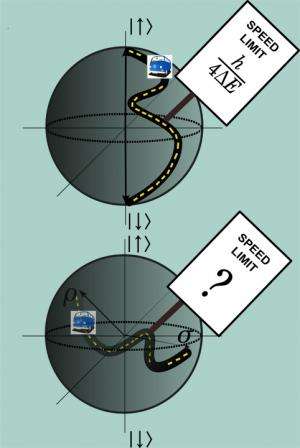January 26, 2015 report
Best of Last Week – Setting a quantum speed limit, slowing the speed of light and turning back the aging clock

(Phys.org)—It was a very busy week for physics research. A team of scientists has set a quantum speed limit—the group at the University of California found a way to prove a fundamental relationship between energy and time, the flip side of the Heisenberg uncertainty principle. And researchers at MIT unveiled a new analysis that shows a way to self-propel subatomic particles—it is one of the new ways scientists have found to "trick" the traditional laws of physics. Another was demonstrated by a team of physicists at the University of Glasgow as they found a new way to slow the speed of light—by running a laser beam through a mask causing a change in the shape of photons. Meanwhile, another combined team of researchers in Europe found a way to demonstrate that atoms can be in two places at the same time—they pulled an atom in two directions at once, giving a hint that quantum mechanics may hold for large objects.
In space news, researchers with SISSA in Trieste found that in theory, the Milky Way could be a "galactic transport system"—their ideas are based on combining dark matter maps with the Big Bang model, which suggests the possibility of space tunnels, they report, such as was seen recently in the movie Interstellar. Also, another team led by researchers at Cambridge University uncovered hidden magnetic messages in meteorites—revealing the dying moments of the magnetic fields of asteroids and offering hints of the fate of Earth's magnetic field.
In other news, a team at the University of Rochester found that laser-generated surface structures can create extremely water-repellent metals—allowing for super-hydrophobic materials without the need for special coatings. And a team of researchers working at the University of Maryland found that a common eye disease may be set off by very small mineral deposits—offering a possible preventative strategy for helping to avoid developing macular degeneration. And another team managed to grab a 3-D view of the Greenland Ice Sheet, opening a window on ice history.
And finally, if you have been wondering if scientists might figure out a way to allow people to live longer, or even forever, in your own lifetime, a team at Stanford found that a telomere extension technique turned back the aging clock in cultured human cells—as we age the chromosome caps grow shorter; this new technique reversed that process, allowing actual human cells to act young again—so, perhaps immortality, at least for some, might be near at hand after all.
© 2015 Phys.org





















